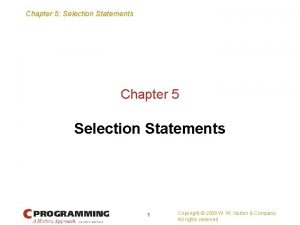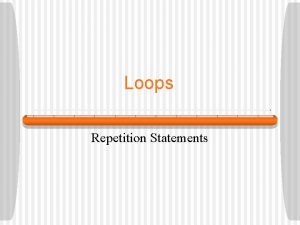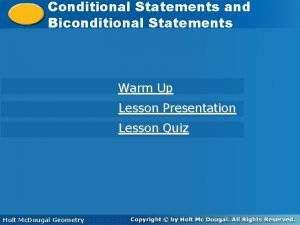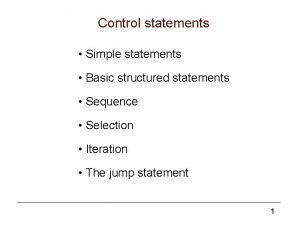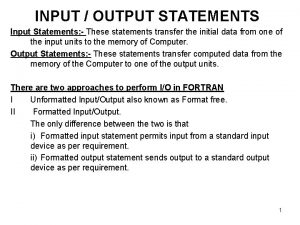Selection Statements Selection Statements Selection statements allows our










![Example: public class Grade { public static void main( String[] args ) { double Example: public class Grade { public static void main( String[] args ) { double](https://slidetodoc.com/presentation_image_h2/5eb895d6d4fd68fa62af2a01c8fdfe6e/image-11.jpg)


![Example: public class Grade { public static void main( String[] args ) { int Example: public class Grade { public static void main( String[] args ) { int](https://slidetodoc.com/presentation_image_h2/5eb895d6d4fd68fa62af2a01c8fdfe6e/image-14.jpg)
- Slides: 14

Selection Statements

Selection Statements ► Selection statements allows our program to choose different paths of execution based on the outcome of an expression or the state of the variable. ► The expression or the value upon which a decision is made is always a boolean value(true or false). ► 2 kinds of selection statements § if or if…else § switch

The if structure ►A single if statement is sometimes called a singlealternate if because we only perform an action based on one alternative. syntax: if( condition ) statement; or if(condition ){ statement 1; statement 2; }

Example: int grade = 68; if( grade > 60 ) System. out. println("Congratulations!"); ------------------------------------------ int grade = 68; if( grade > 60 ){ System. out. println("Congratulations!"); System. out. println("You passed!"); }

The if…else structure ► The if…else structure is a dual-alternate if, which requires two options for the next course of action. ► It provides the mechanism to perform one action when a boolean expression evaluates as true and performs another action when the boolean expression evaluates as false

syntax: if( boolean_expression ){ statement 1; statement 2; . . . } else{ statement 3; statement 4; . . . }

Example: int grade = 68; if( grade > 60 ) System. out. println("Congratulations!"); else System. out. println("Sorry you failed"); ----------------------------------------------- int grade = 68; if( grade > 60 ){ System. out. println("Congratulations!"); System. out. println("You passed!"); } else{ System. out. println("Sorry you failed"); }

Nested if…else Structure | syntax: if( condition 1 ) statement 1; else if( condition 2 ) statement 2; else statement 3; | | | | | Example: int grade = 68; if( grade > 90 ){ System. out. println("Very good!"); } else if( grade > 60 ){ System. out. println("Very good!"); } else{ System. out. println("Sorry you failed"); }

Common Errors 1. The condition inside the if-statement does not evaluate to a boolean value. For example, //WRONG int number = 0; if( number ){ //some statements here } v The variable number does not hold a boolean value. 2. Writing elseif instead of else if.

3. Using = instead of == for comparison. For example, //WRONG int number = 0; if( number = 0 ){ //some statements here } This should be written as, //CORRECT int number = 0; if( number == 0 ){ //some statements here }
![Example public class Grade public static void main String args double Example: public class Grade { public static void main( String[] args ) { double](https://slidetodoc.com/presentation_image_h2/5eb895d6d4fd68fa62af2a01c8fdfe6e/image-11.jpg)
Example: public class Grade { public static void main( String[] args ) { double grade = 92. 0; if( grade >= 90 ){ System. out. println( "Excellent!" ); } else if( (grade < 90) && (grade >= 80)){ System. out. println("Good job!" ); } else if( (grade < 80) && (grade >= 60)){ System. out. println("Study harder!" ); } else{ System. out. println("Sorry, you failed. "); } } }

The switch structure ► The switch statement is useful when we need to test a single variable against a series of exact integer or character values. § keyword switch starts the structures and is followed immediately by a test expression enclosed in parenthesis § keyword case is followed by one of the possible values for the test expression and a colon § keyword break optionally terminates values of the test expression and a colon § keyword default optionally used to prior to any action that should occur if the test variable does not match any case

syntax: switch( switch_expression ){ case_selector 1: statement 1; // statement 2; //block 1 break; case_selector 2: statement 1; // statement 2; //block 2 break; : default: statement 1; // statement 2; //block n }
![Example public class Grade public static void main String args int Example: public class Grade { public static void main( String[] args ) { int](https://slidetodoc.com/presentation_image_h2/5eb895d6d4fd68fa62af2a01c8fdfe6e/image-14.jpg)
Example: public class Grade { public static void main( String[] args ) { int grade = 92; switch(grade){ case 100: System. out. println( "Excellent!" ); break; case 90: System. out. println("Good job!" ); break; case 80: System. out. println("Study harder!" ); break; default: System. out. println("Sorry, you failed. "); } } }
 Awareness of ourselves and our environment is:
Awareness of ourselves and our environment is: Christ be our light bernadette farrell
Christ be our light bernadette farrell Our awareness of ourselves and our environment.
Our awareness of ourselves and our environment. Our life is what our thoughts make it
Our life is what our thoughts make it God our father christ our brother
God our father christ our brother Marcus aurelius our life is what our thoughts make it
Marcus aurelius our life is what our thoughts make it Money madness written by
Money madness written by Thinking affects our language which then affects our
Thinking affects our language which then affects our Our future is in our hands quotes
Our future is in our hands quotes We bow our hearts we bend our knees
We bow our hearts we bend our knees Awareness of ourselves and our environment is
Awareness of ourselves and our environment is Our census our future
Our census our future Awareness of ourselves and our environment is
Awareness of ourselves and our environment is Our census our future
Our census our future Spoken word poetry allows you to be anyone you want to be
Spoken word poetry allows you to be anyone you want to be
















